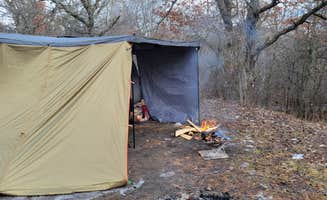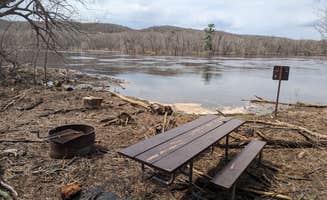Dispersed camping near Fridley, Minnesota provides budget-friendly options with minimal development. Sand Dunes State Forest remains the primary destination, with primitive camping permitted along forest roads about 60 minutes northwest of Fridley. Recent visitors note varying road conditions with gravel surfaces that can be rutted after rain. Campsites are typically undesignated pull-offs where vehicles can safely park without blocking traffic, requiring self-sufficiency and adherence to leave-no-trace principles.
What to do
Explore nature trails: Sand Dunes State Forest features multiple hiking routes through pine stands and sandy areas. "I love that it's so close to home. I was able to walk in and find an incredible spot to camp and lay in my hammock," reports Joslyn H. about South of Sand Dunes State Forest.
Visit nearby Lions Park: Take advantage of the crushed gravel path connecting to local parks. At Sandy Cove on the St. Croix River, "The crushed gravel path to the south makes travel to the nearby Lions park easy," notes Travis B., providing an accessible activity option.
Boating and water activities: The St. Croix River sites offer water recreation opportunities. "Pretty campsite with boat ramp to St Croix river," says Aly E. about their experience at County Road O Landing, making it suitable for paddlers and anglers.
What campers like
Wildlife viewing: Birders and nature enthusiasts report diverse wildlife encounters. Heather W. notes, "Stand storks are very protective. Stay away from them. They attack," highlighting the interesting birdwatching opportunities in the forest areas.
Proximity to Minneapolis-St. Paul: Many campers appreciate these sites' accessibility from the Twin Cities. Samuel C. writes, "For the proximity to the city and nearby highways, this was a good spot," making these locations practical for weekend getaways or quick overnight stays.
Privacy between sites: Despite being near urban areas, many dispersed locations provide isolation. "Came back on a warm weekend. A bit more traffic, but after 12 p.m., not much of anything," shares Skip H., indicating quieter periods during certain times.
What you should know
Variable cell service: Connectivity ranges from non-existent to spotty across most sites. "I pulled into the campsite late at night and was really confused where to go. There are bathrooms and 1 bar of Verizon (no T-mobile service)," reports Aly E.
Vehicle considerations: Many forest roads have limitations or seasonal restrictions. Adam W. explains, "The bad part a lot of the side roads are closed to motor vehicles due to some issues they had a couple years ago but are now taken care of like people dumping," indicating changing access conditions.
Law enforcement interactions: Be aware of different interpretations of camping regulations. Jason B. cautions, "I had a county sheriff person tell me it's not lawful to park a trailer and they kicked me out. I called the DNR and they said that wasn't right but I decided to leave anyway."
Tips for camping with families
Insect preparation: Plan for significant insect activity, especially during summer months. Marie G. warns about County Road O Landing: "It was easy to find, and the spot itself was good and had restrooms. The only problem was the mosquitoes."
Traffic awareness: Some dispersed sites experience unexpected vehicle traffic. Ryan P. observes, "This road is pretty busy for a dirt forest road and people FLY down it. Almost got hit a few times walking," highlighting safety considerations for families with children.
Early morning nature opportunities: Dawn provides unique wildlife experiences. Aly E. mentions waking up to "amazing bird calls" before 6am, suggesting early mornings as prime times for nature activities with children.
Tips from RVers
Size limitations: Most dispersed sites accommodate smaller recreational vehicles only. Skip H. advises, "Great spot. Plenty of parking. Best for straight vehicles or very small trailers," emphasizing the limitations for larger setups.
Overhanging branches: Some sites have low clearance issues. Gregory notes, "We did find one we thought we liked, but branches over hung, and rested on our camper (8ft high) and in fact most sites were shaded," warning taller RVs about potential obstacles.
Site selection timing: Arriving during daylight hours improves site selection. Samuel C. suggests, "There are a few spots that have great views or pull-through areas, and there are limited spots that are big-rig friendly," indicating the importance of early arrival to secure suitable locations.



